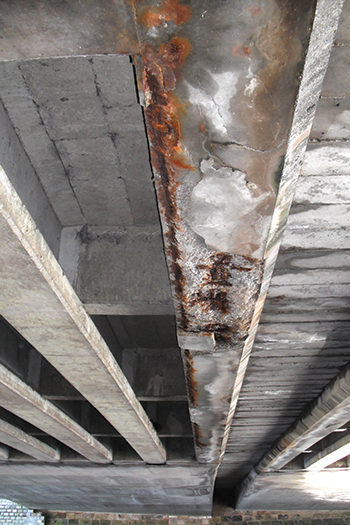
 Chloride-affected concrete ... a typical application for Cementitious Coating 851.
Chloride-affected concrete ... a typical application for Cementitious Coating 851.
Tests carried out on UK’s Flexcrete’s Cementitious Coating 851 have confirmed the compound’s ability to provide an effective barrier to chlorides for a minimum of 29 years.
In 1988, a 2-mm-thick film of Cementitious Coating 851 was applied to a concrete slice and sealed in a chloride ion diffusion cell and it is still going strong some 29 years (10,586 days) later. Ongoing independent tests carried out in the Vinci Construction Technology Centre laboratory in Bedfordshire, UK, show that the barrier properties of 851 have not changed after a test period spanning the past 29 years, according to the company.
Chris Lloyd, co-founder of Flexcrete Technologies, says: “Cementitious Coating 851 has not shown any signs of deterioration despite being fully immersed in the chloride solution for over 29 years. In Vinci’s experience, many coating systems degrade over time when on test in the cell and even products that initially perform well can subsequently blister, resulting in more chloride ions passing through the product. The performance of Cementitious Coating 851 in this test is unparalleled.”
Vinci’s internal testing can now determine a chloride ion diffusion coefficient from non-steady state conditions. Based on the total chloride quantity that has been determined to diffuse through the 851 coating during 29 years on test, it has been calculated that this equates to a chloride ion diffusion coefficient of 1.23x10-12 sq cm/s. By comparison for the uncoated reference concrete specimen, a chloride ion diffusion coefficient of 1.03x10-8 sq cm/s was calculated based on the total chloride quantity that had diffused in the first 98 days on test when steady state was achieved. To put this in context, it would have taken 271 years for the product cell with the 851 to reach the same chloride concentration that the uncoated specimen reached in just 98 days.
Cementitious Coating 851 is manufactured by Flexcrete Technologies, part of the AkzoNobel group of companies. The highly advanced, two-component, waterborne cementitious modified polymer coating – originally introduced by Flexcrete back in 1985 - is also known in overseas markets under the AkzoNobel brand name of Intercrete 4841.
“Today, Cementitious Coating 851 remains one of the most effective products for providing structural protection against chloride attack. 851 is typically specified on both existing and new structures to waterproof concrete, reinstate concrete cover and provide an effective barrier to chloride ingress, amongst many other challenges typically encountered on buildings, infrastructure and structures in sectors such as coastal, highways and the water and waste water industry,” says Lloyd, adding a 2-mm coating of Cementitious Coating 851 is equivalent to 100 mm of good quality concrete cover.
Cementitious Coating 851 resists 10 bar positive and negative pressure under a 100-m head, forming a hard, highly alkaline coating which not only protects concrete from the effects of aggressive acid gases, moisture and chlorides, but also has greatly enhanced chemical resistance.
The coating has been extensively used on Crossrail developments in London and all around the world on projects, such as at Abu Dhabi International Airport, the Gorgon LNG Project in Australia and Hong Kong’s West Kowloon Expressway.
Being cement based, 851 chemically reacts with the substrate to form an integral part and will have a design life equivalent to that of the concrete to which it is applied.





















_0001.jpg)


.jpg)
















.jpg)








.jpg)




